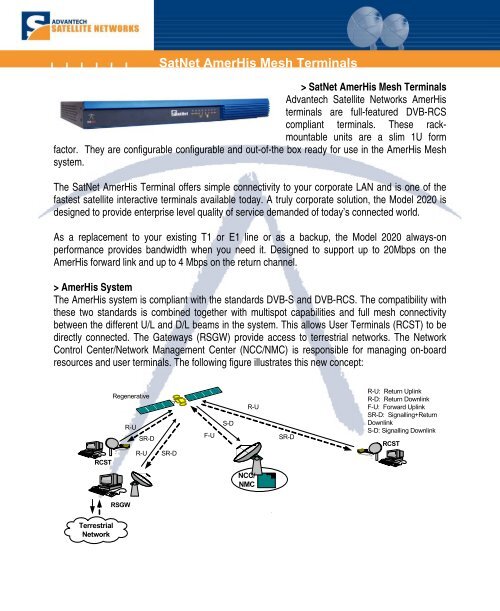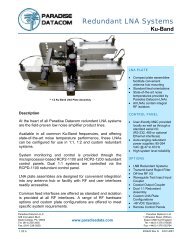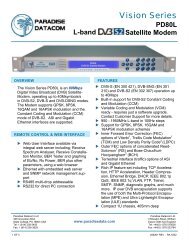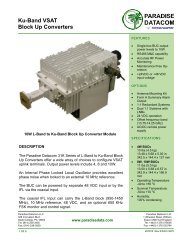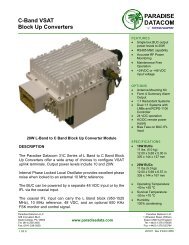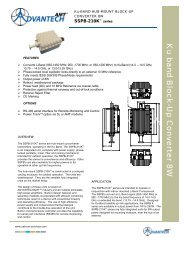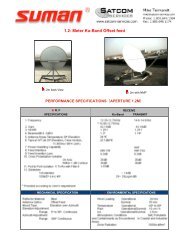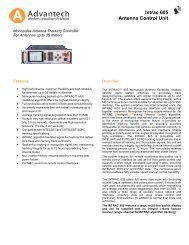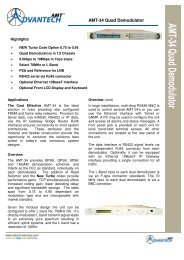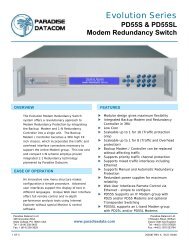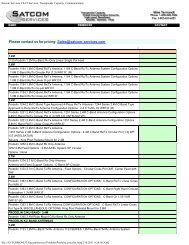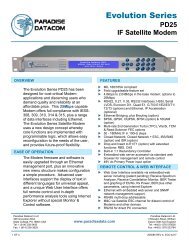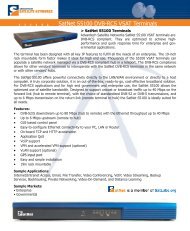AmerHIS Terminal Data Sheet [PDF (142 KB) - Satcom Services
AmerHIS Terminal Data Sheet [PDF (142 KB) - Satcom Services
AmerHIS Terminal Data Sheet [PDF (142 KB) - Satcom Services
Create successful ePaper yourself
Turn your PDF publications into a flip-book with our unique Google optimized e-Paper software.
SatNet AmerHis Mesh <strong>Terminal</strong>s<br />
> SatNet AmerHis Mesh <strong>Terminal</strong>s<br />
Advantech Satellite Networks AmerHis<br />
terminals are full-featured DVB-RCS<br />
compliant terminals. These rackmountable<br />
units are a slim 1U form<br />
factor. They are configurable configurable and out-of-the box ready for use in the AmerHis Mesh<br />
system.<br />
The SatNet AmerHis <strong>Terminal</strong> offers simple connectivity to your corporate LAN and is one of the<br />
fastest satellite interactive terminals available today. A truly corporate solution, the Model 2020 is<br />
designed to provide enterprise level quality of service demanded of today’s connected world.<br />
As a replacement to your existing T1 or E1 line or as a backup, the Model 2020 always-on<br />
performance provides bandwidth when you need it. Designed to support up to 20Mbps on the<br />
AmerHis forward link and up to 4 Mbps on the return channel.<br />
> AmerHis System<br />
The AmerHis system is compliant with the standards DVB-S and DVB-RCS. The compatibility with<br />
these two standards is combined together with multispot capabilities and full mesh connectivity<br />
between the different U/L and D/L beams in the system. This allows User <strong>Terminal</strong>s (RCST) to be<br />
directly connected. The Gateways (RSGW) provide access to terrestrial networks. The Network<br />
Control Center/Network Management Center (NCC/NMC) is responsible for managing on-board<br />
resources and user terminals. The following figure illustrates this new concept:<br />
Regenerative<br />
R-U<br />
SR-D<br />
R-U<br />
RCST<br />
SR-D<br />
F-U<br />
S-D<br />
R-U<br />
SR-D<br />
R-U: Return Uplink<br />
R-D: Return Downlink<br />
F-U: Forward Uplink<br />
SR-D: Signalling+Return<br />
Downlink<br />
S-D: Signalling Downlink<br />
RCST<br />
NCC/<br />
NMC<br />
RSGW<br />
Terrestrial<br />
Network
The main characteristics of the AmerHis system are:<br />
• The up-link uses MF-TDMA according to the DVB-RCS standard, MPEG profile<br />
• The down-link is fully DVB-S compatible<br />
• A digital processor on-board the satellite allows to route MPEG packets from up-link to downlink<br />
beams in a flexible way with on-board multicast support<br />
• The system implements a sophisticated connection control scheme, called C2P (note: this is<br />
not the same than the SatLabs’ CCP protocol), allowing point-to-point as well as point-tomultipoint<br />
connections<br />
• The system supports single hop connectivity between users (mesh connectivity) system; C2P<br />
allows to establish connection between Gateway and RCST<br />
• The SatNet AmerHis <strong>Terminal</strong> can be reconfigured to support regular DVB-RCS star and/or<br />
AmerHis mesh system through through two different software loads<br />
• Beam coverage: Ku band, Europe, Brazil, North and South America<br />
• The system supports symmetric predictive traffic, as well as bursty traffic generated by a large<br />
number of users, owing to dynamic allocation<br />
• The system supports access to external networks via the RSGWs such as PSTN and ISDN as<br />
well as private IP networks belonging to ISPs<br />
• The system supports integrated IP based data services<br />
• ISPs can manage their own low-cost gateway (RSGW) and provide Internet access to their<br />
subscribers; services such as VoIP and video conferencing can be provided; ISPs choose<br />
their own SLAs<br />
• Companies can set up their own VPNs and share their allocated capacity between all their<br />
sites; the AmerHis system allows the scheduling of specific connectivity requirements<br />
• The AmerHis payload offers multiplexing and demultiplexing of MPEG-2 transport streams and<br />
is therefore capable of offering IP services over MPEG-2 as well as routing video
<strong>Terminal</strong> Features:<br />
• Up to 20Mbps downstream; up to 4Mbps upstream<br />
• Web Based Control Panel;<br />
• Easy-to-configure Ethernet connectivity to your LAN or Router;<br />
• Complete turnkey solution, you are on-line in hours;<br />
• On-board TCP acceleration and IPSec options<br />
• Application QoS<br />
• Support for Multiple Subnets<br />
• Fully upgradeable design<br />
> Sample Markets:<br />
• Enterprise/Corporate<br />
• Government<br />
• WiFi / Community hot spots<br />
• Education<br />
• Telemedicine<br />
• Broadcast / SNG / Content Origination<br />
• Multi-Dwelling/Tenant Units<br />
• Cable Head end/Last Mile<br />
> Sample Applications:<br />
Email and Web Browsing, File Transfer, Video Streaming, VPN, VoIP, Cable Head-end, Video<br />
Conferencing, Corporate Networking, Multicasting, Broadcasting, Thin client, Video-On-Demand,<br />
Backup, Distance Learning, Point-Of-Sale, SCADA.<br />
Especially well suited to delay sensitive applications like VoIP, Video Conferencing, Distance<br />
Learning.<br />
> Frequency Combinations Potential Dimensioning Sets (worst case for Europe and Brazil)<br />
• Class 1, 512kbps uplink: 1.8m/2W<br />
• Class 2, 1.036Mbps uplink: 1.8m/4W<br />
• Class 3, 2.073Mbps uplink: 2.4M/ 4W<br />
• Class 4, 4.147Mbps uplink: 2.4M/ 8W (external power supply)
SATNET AMERHIS MESH TERMINAL FEATURES & SPECIFICATIONS<br />
• Sample <strong>Services</strong>: DVB-RCS, TCP/IP, UDP/TCP, Unicast, Multicast, Broadcast<br />
• Protocols: FTP, HTTP, SNMP, ICMP, IGMP<br />
• Air Interface: DVB-RCS<br />
o MPEG/DVB-S downstream;<br />
o MPEG / MF-TDMA upstream: 3 or 4 MPEG packets per burst (Configuration 1) and 1<br />
MPEG packet per burst (Configuration 2) supported<br />
o 24 MPEG packets per burst (Configuration 3) NOT supported<br />
• Coding: Concatenated Reed-Solomon and Convolutional FEC downstream, Turbo coding<br />
upstream<br />
• Modulation: QPSK Receive; QPSK Transmit<br />
• <strong>Data</strong> Rates: Up to 20Mbps downstream and up to 4Mbps Upstream<br />
• Upstream Burst Rates: 350.988 ks/s (C1), 701.976 ks/s (C2), 1403.952 ks/s (C3), 2807.904<br />
ks/s (C4), depending on beam coverage and ODU size<br />
• Demand assignment: CRA, RBDC, FCA supported<br />
• Network Interface: Ethernet 10/100 BaseT<br />
• ODU Interface: L-Band Rx; L-Band Tx<br />
• IP Networking: DHCP server<br />
• Network Management: SNMP Compatible, Web access, over the air S/W upgrade<br />
• BUC Size: 1-8W, depending on model, internal vs external power supply<br />
• Supply Voltage : 100-240 VAC; 50Hz / 60 Hz<br />
• Certifications : CE, FCC, UL, CSA<br />
• Outdoor Units should be dimensioned for each satellite & application on a case by case basis<br />
to satisfy needs & requirements:<br />
o <strong>Data</strong> Rate<br />
o Dish size<br />
o Tx Power<br />
o Link Quality<br />
o Availability
Amerhis System Coverage Summary (based on Alcatel recommendation)<br />
European Beam:<br />
Symbol Rate Class 1 Class 2 Class 3 Class 4<br />
ODU Size 1.8m/2W 1.8m/4W 2.4m/4W 2.4m/8W<br />
Frequency band Extended<br />
Polarization<br />
Linear, Orthogonal<br />
Availability<br />
99.5% Uplink; 99.8% Downlink (27 Msps DVB-S)<br />
Coverage area Spain and Portugal; Sizing based on worst location: Mahon<br />
Brazilian Beam:<br />
Symbol Rate Class 1 Class 2 Class 3 Class 4<br />
ODU Size 1.8m/2W 1.8m/4W 2.4m/4W 2.4m/8W<br />
Frequency band Standard<br />
Polarization<br />
Linear, Orthogonal<br />
Availability<br />
Coverage area<br />
99.5% Uplink; 99.8% Downlink (27 Msps DVB-S)<br />
Major cities in Brazil vis-à-vis Brasilia, Sao Poulo, Rio De Janeiro, Salvador, Vitoria, Porto<br />
Alegre, Curitiba, Belo Horizonte are covered. Sizing based on worst location: Brasilia<br />
North American Beam:<br />
Symbol Rate Class 1 Class 2 Class 3 Class 4<br />
ODU Size 1.8m/2W 1.8m/4W<br />
2.4m/8W<br />
3.0m/8W<br />
2.4m/2W<br />
3.0m/4W<br />
Frequency band Extended<br />
Polarization<br />
Linear, Orthogonal<br />
Availability<br />
99.5% Uplink; 99.8% Downlink (27 Msps DVB-S)<br />
Coverage area Region identified as NA below; Sizing based on worst location: Miami<br />
South American Beam:<br />
Symbol Rate Class 1 Class 2 Class 3 Class 4<br />
ODU Size 2.4m/2W 2.4m/4W 2.4m/8W<br />
3.0m/8W<br />
3.0m/4W<br />
Frequency band Extended<br />
Polarization<br />
Linear, Orthogonal<br />
Availability<br />
99.5% Uplink; 99.8% Downlink (27 Msps DVB-S)<br />
Coverage area Major cities in Peru, Ecuador, Colombia, Uruguay, Paraguay and Chile; Sizing based on<br />
worst location: Trinidad<br />
Advantech Satellite Networks<br />
a division of Advantech AMT<br />
2341 Alfred-Nobel, 4th Floor<br />
Saint Laurent (Montreal), Quebec, Canada H4S 2A9<br />
Tel.: +1-514-335-3550<br />
Fax: +1-514-335-6386<br />
satnet_sales@advantechamt.com<br />
www.advantechamt.com


